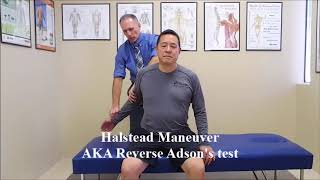Halstead test
- Fysiobasen

- Sep 15
- 2 min read
The Halstead Test is a clinical examination used to assess thoracic outlet syndrome (TOS). Thoracic outlet syndrome occurs when structures such as nerves or blood vessels are compressed in the area between the neck and shoulder. Historically, this test has been used to identify possible arterial or neural compression in this region. It is important to note that the evidence supporting the Halstead Test is limited, and different descriptions of the procedure exist in the literature.

Advantages and Limitations
The advantage of the Halstead Test is that it is simple to perform in a clinical setting without requiring special equipment. It can provide a quick indication of thoracic outlet syndrome, particularly in cases of arterial compression. The limitation is that the test has weak scientific support, and results may be influenced by patient mobility, pain, or muscle tension. Therefore, it should always be combined with other clinical tests, such as Adson’s Test or Wright’s Test, to establish a more reliable diagnosis.
Execution of the Test
The patient may be seated or standing
The examiner palpates the patient’s radial pulse on the tested side
While monitoring the pulse, the patient’s arm is abducted to 45°, extended to 45°, and externally rotated
The examiner applies a gentle downward traction on the arm to increase distraction
The patient is instructed to rotate the head fully away from the tested side and extend the neck
During the maneuver, the examiner assesses whether the radial pulse diminishes or disappears, and whether the patient experiences numbness, tingling, or pain
Interpretation of Results
Positive test: Diminished or absent radial pulse, or reproduction of symptoms such as numbness, tingling, or pain in the arm
Implication: May indicate compression of blood vessels or nerves in the thoracic outlet
Evidence Base and Clinical Relevance
The Halstead Test has very limited documentation in the literature. It is recommended to use it in conjunction with other clinical tests, such as Adson’s Test, Roos Test, or Wright’s Test, for a more comprehensive evaluation of thoracic outlet syndrome. Some sources also note that the positioning of the Halstead Test resembles the Costoclavicular Test, which evaluates whether the clavicle compresses neurovascular structures against the first rib. Therefore, results should always be interpreted in the context of the patient’s overall symptoms and clinical findings.
Summary
The Halstead Test is a simple clinical maneuver for detecting possible compression of neurovascular structures in the thoracic outlet. While easy to perform, its diagnostic accuracy is weak, and it should always be combined with other TOS assessments. A positive result may suggest arterial or neural compression, but further evaluation is needed for a reliable diagnosis.
Sources:
Hixson KM, Horris HB, McLeod TCV, Bacon CEW. The Diagnostic Accuracy of Clinical Diagnostic Tests for Thoracic Outlet Syndrome. J Sport Rehabil. 2017 Sep;26(5):459-465.
Demirbag D, Unlu E, Ozdemir F, Genchellac H, Temizoz O, Ozdemir H, Demir MK. The relationship between magnetic resonance imaging findings and postural maneuver and physical examination tests in patients with thoracic outlet syndrome: results of a double-blind, controlled study. Arch Phys Med Rehabil. 2007 Jul;88(7):844-51.









